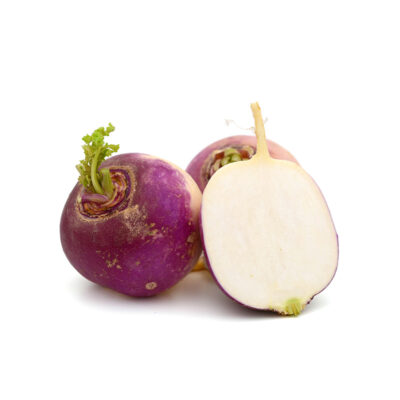Is Turnip Good for Diabetes? Plus 5 Health Benefits
Turnip is a healthy vegetable that has many amazing benefits. Many people believe it’s good for diabetes management, but is that true? We explain the nutritional value of turnips and how they might settle blood sugar levels in those with type 2 diabetes.

Turnips are a super healthy food that contains lots of nutrients.
People with diabetes might wonder if they can eat this root vegetable in their diet. The vitamins, minerals, and antioxidants may benefit diabetes management. Eating turnip might be one great way to lower your blood sugar level and improve glycemic control in type 2 diabetes.
Any type of plant-based food will strengthen your overall health. Managing blood sugar means you need to follow a healthy diet that contains lots of minerals. Just one portion of turnip has everything you need, like vitamin C, potassium, and vitamin D for the heart.
But how does turnip help with diabetes exactly?
In this article, you’ll discover whether turnips are good for a diabetes diet.
Is Turnip Good for Diabetes?
Yes, eating turnips can help reduce the symptoms of diabetes. They contain fiber that will slow down sugar absorption, preventing blood sugar spikes in those with hyperglycemia. A healthy diet comprising plant-based foods may keep blood glucose levels steady.
Root vegetables like turnips, rutabagas and taro are great for keeping your blood sugar below 140 mg/dL. This can stop symptoms associated with excess sugar in the bloodstream. If you often experience increased thirst, dry mouth, and severe tiredness, try eating more non-starchy vegetables.
You can also add turnips to a ketogenic diet, which is a diet that may be good for diabetes. Eating low-carb and high-fat foods can maintain glucose production. The lower intake of carbohydrates reduces blood sugar spikes, helping those with diabetes to feel healthy after nutritious meals.
Certain vitamins in turnips strengthen your heart and prevent cardiovascular diseases. Vitamin K and B-complex groups lower the risk of diseases by 34%, depending on how much you eat. This is excellent for people who need to improve their blood vessels.
Just remember that eating root vegetables alone won’t significantly reduce physical symptoms. You need to go for a long run or stay regularly active every day to manage diabetes. Regular exercise improves insulin sensitivity, which helps regulate blood glucose storage.
Turnip Nutritional Value
A portion of turnip greens contains many nutrients that benefit those with diabetes. Cruciferous vegetables usually have lots of fiber that manage blood sugar levels. You can even drink turnip juice if you want more of the vegetable in your diet, but make sure it’s not store-bought juice.
Here is the nutritional value of raw turnips per 100g serving:

There aren’t many carbs, sugar, calories, or fats that can damage your health. Consuming minimal carbohydrates ensures you don’t experience sudden blood glucose spikes. On average, you should aim to eat less than 60 grams of carbs in each big meal during the day.
Since there are only 1.8 grams of fiber, consume other fiber-rich foods to further slow sugar absorption. Root vegetables like radishes, sweet potato, beets, rutabagas, carrots, celery root, and other forms of turnips contain soluble fiber that maintains blood sugar levels.
Glycemic Index of Turnips
The glycemic index (GI) of turnips is 62, which falls into the medium GI category. Foods above 55 usually don’t work well with type 2 diabetes. However, that depends on the type of product, as junk food exceeding 55 will only increase sugar in your bloodstream.
A diabetes-friendly diet should always comprise foods that score low on the GI scale. This ensures your body doesn’t release too much sugar and cause physical symptoms. Even though turnips are 62, you can still eat them in small portions and limit how much you have each week.
This glycemic index can also change depending on how you cook turnips. If you add seasoning and sauces, this might increase the GI score. Roasting them with certain oils can also contribute to a higher GI, so be careful when cooking turnips for your diabetes-friendly meals.
5 Health Benefits of Turnips for Diabetes
High-fiber diets containing turnips have many benefits for diabetes. You can also incorporate other green vegetables like asparagus, broccoli, green cabbage, spinach, Brussels sprouts, kale, and celery. These hold essential nutrients for improving your overall health.
Let’s take a look at the five benefits of eating turnips:
#1 Aids weight loss
A 100-gram portion of turnips only has 28 calories, making them perfect for losing weight. This food also contains lipids – organic compounds that boost your metabolism. A faster metabolism means your body burns extra calories throughout the day, leading to better fat loss over time.
To lose more stubborn weight, consider trying the ketogenic diet. Turnips are keto-friendly and may encourage ketone production in your body. This occurs when you enter a state of ketosis, which pushes the body to burn fat for energy instead of carbohydrates and glucose.
#2 Keeps liver healthy
Turnips or pure turnip juice can help strengthen your liver functions.
Vitamin C, polyphenols, and flavonoids specifically regenerate liver cells, which enhances the structure of this organ. The anti-inflammatory effects of turnips can also prevent kidney diseases in older adults. If you already suffer from kidney problems, try eating more turnips in your diet.
#3 Source of antioxidants
Vitamin C and vitamin K in turnips have antioxidant properties that reduce diabetes-related complications. These problems might be headaches, severe exhaustion, blurred vision, and shortness of breath. High-vitamin foods that eliminate those hyperglycemia symptoms.
Dietary antioxidants may help lower blood sugar, preventing damaged blood vessels and arteries. This will eventually strengthen your heart and decrease the risk of cardiovascular diseases. Just one cup of turnips has enough antioxidants to improve your general health.
#4 Has anti-inflammatory benefits
Certain health conditions may harden arteries and cause long-term heart inflammation. Type 2 diabetes is often associated with inflammatory symptoms that lead to heart disease. However, eating nutritious foods like turnips can fuel your body with protective compounds.
The anti-inflammatory benefits are also excellent for maintaining bone health. Both calcium and vitamin D can stop bones from deteriorating due to age. Consuming turnips in your diet may prevent future health problems like osteoporosis, rheumatoid arthritis, and cervical spondylosis.
#5 Helps your gut
You should consume high-fiber diets to improve your gut. Turnips and other foods like sweet potatoes, celery, and leafy greens can reduce bloating and painful digestive gas. High blood sugar sometimes damages nerves in the intestines, leading to serious constipation.
Vitamin C and vitamin K also feed your gut healthy bacteria, which may boost your immune system. Other nutrients like magnesium can help food digest properly in the digestive tract. Stronger bowels mean your arteries and nerves may not get damaged by blood glucose.
FAQs
There are 3.8 grams of sugar per 100-gram serving of raw turnips. This is purely natural sugar that may keep your metabolism stable. However, just be aware that eating too many turnip roots in one day might raise blood sugar levels, so only have this food in smaller portions.
Yes, many people believe that turnip roots have anti-diabetic effects. The vitamins and minerals lower blood sugar and low-density lipoprotein (LDL cholesterol). A study suggests that just 90–180 mg of turnip root extract can help lower sugar and cholesterol levels.
No, there isn’t a rule that states you have to peel turnips. You can simply cut the root and wash turnips before cooking them. Some people might prefer to remove the skin of turnips, as this could help them boil properly. However, the choice is completely down to your preferences.
A Word From Our MD
Fresh turnips are excellent for lowering sugar in your bloodstream.
Even though they don’t have a low glycemic index, they still promote strong heart health. You can eat smaller portions of turnips throughout the week or limit how much you have in each meal plan. Turnips don’t have added sugar either. Making them perfect for your diet.
Many vitamins and minerals can maintain healthy skin and improve your immune system over time. The high-fiber content also contributes to natural functions in the body. If you want to feel generally stronger, eat more turnips and other foods that comprise soluble fiber and B vitamins.
Just remember that eating turnips alone won’t treat type 2 diabetes. You can talk to a doctor about the right meal plan or exercise routine to reduce symptoms. It’s all about finding a regime that helps with diabetes management but also keeps you at a healthy weight.
Conclusion
So, are turnips actually good for managing diabetes?
The cruciferous vegetable family can definitely control sugar in your bloodstream. A root vegetable like a turnip contains all the nutrients you need to stay healthy. People with diabetes should aim to eat this food once a week, along with other delicious root vegetables.
Just make sure to also get regular exercise, like long-distance walks and runs. Pairing physical activity with a healthy meal plan will help lower blood glucose levels. Exercise can be great for weight loss, especially if you struggle with losing weight on a diabetes-friendly diet.

















































 Select your language:
Select your language: 








